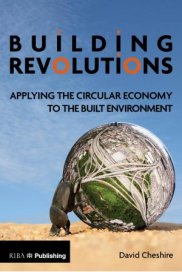Building Revolutions - review
| Line 36: | Line 36: | ||
=== Related articles on Designing Buildings Wiki === | === Related articles on Designing Buildings Wiki === | ||
| + | * Better Buildings: Learning from buildings in use - review. | ||
* Bill Gething and Katie Puckett - Design for Climate Change. | * Bill Gething and Katie Puckett - Design for Climate Change. | ||
* Biomimicry in Architecture - review. | * Biomimicry in Architecture - review. | ||
Revision as of 16:51, 19 May 2017
‘Building Revolutions: Applying the circular economy to the built environment’
David Cheshire
Published by RIBA Publishing (2016)
It is predicted that by 2030, 3 billion people who are currently living in poverty will have a middle class level of consumption. This will create a surge in the demand for natural resources by at least a third.
With these forecasts in mind, and with the construction industry playing such an important part in global resource demand, experts are increasingly looking at strategies for moving the built environment away from the linear economy of ‘make, use and dispose’, sometimes more disparagingly described as 'make, break and discard'.
The more effective model, according to the book by David Cheshire, a Regional Director at infrastructure services firm AECOM, is that of the ‘circular economy’. This follows the basic principle that where resources are kept in use, their value is retained.
In the circular economy, everything is engineered to be constantly reused or recycled. It requires rethinking of design, manufacturing, selling, re-using, recycling and consumer ownership to keep resources in use for as long as possible.
Cheshire asserts that embracing principles of the circular economy could yield a number of benefits to the construction industry, in terms of cost, efficiency and environment. Although he acknowledges that as buildings are not ‘manufactured’ in the same way as consumer products, it is more of a challenge to apply the circular economy model.
With this in mind, the overarching philosophy of the book is to put thought into the future destiny of the building and the legacy that it leaves for following generations. It should not inhibit design, but be used as a catalyst and inspiration.
The book argues that redefining waste as a resource means that costs can be reduced, and companies can be protected against volatile prices associated with raw materials; perhaps mindful of the recent ‘steel dumping’ on the part of China that has had such a negative impact on British steel manufacturers.
The book makes the point that buildings could be adapted, reconstructed and deconstructed, and made from materials that can be reused or recycled, helping create a regenerative built environment. Indeed, designing for deconstruction is ‘an essential piece of the circular economy puzzle’.
The idea of designing in layers helps to unlock the tricky problem of applying the circular economy to buildings, by allowing designers to approach each building element according to its own circumstances.
Building for adaptability is another key principle of the circular economy and a growing trend, according to the book. This approach gives building owners a flexible portfolio, helping them react to changing market needs. A building with a flexible interior within its existing envelope, for example, could be easily adapted from office to hotel space if required.
Cheshire’s book is concise, well-illustrated and easy-to-understand, and serves as an informative introduction to a subject that should be gaining far more attention and inspiring much more focus within the industry.
You can purchase the book at RIBA Bookshop.
Find out more
Related articles on Designing Buildings Wiki
- Better Buildings: Learning from buildings in use - review.
- Bill Gething and Katie Puckett - Design for Climate Change.
- Biomimicry in Architecture - review.
- Circular economy.
- Cradle to cradle product registry system.
- Design for deconstruction.
- FutuREstorative - review.
- How Buildings Work - review.
- Recyclable construction materials.
- Site waste management plan.
- Sustainable materials.
Featured articles and news
Infrastructure that connect the physical and digital domains.
Harnessing robotics and AI in challenging environments
The key to nuclear decommissioning and fusion engineering.
BSRIA announces Lisa Ashworth as new CEO
Tasked with furthering BSRIA’s impressive growth ambitions.
Public buildings get half a million energy efficiency boost
£557 million to switch to cleaner heating and save on energy.
CIOB launches pre-election manifesto
Outlining potential future policies for the next government.
Grenfell Tower Inquiry announcement
Phase 2 hearings come to a close and the final report due in September.
Progress from Parts L, F and O: A whitepaper, one year on.
A replicated study to understand the opinion of practitioners.
ECA announces new president 2024
Electrical engineer and business leader Stuart Smith.
A distinct type of countryside that should be celebrated.
Should Part O be extended to existing buildings?
EAC brands heatwave adaptation a missed opportunity.
Definition of Statutory in workplace and facilities management
Established by IWFM, BESA, CIBSE and BSRIA.
Tackling the transition from traditional heating systems
59% lack the necessary information and confidence to switch.
The general election and the construction industry
As PM, Rishi Sunak announces July 4 date for an election.
Eco apprenticeships continue help grow green workforce
A year after being recognised at the King's coronation.
Permitted development rights for agricultural buildings
The changes coming into effect as of May 21, 2024.






















